Things They Buried
The LDS Church just admitted the 1886 polygamy revelation is real. I'm exposing what they still won't - how its theology steals children and harms mothers. This is part one of my story.
This is not a confession – I’m not looking for forgiveness. It’s an autopsy – I’m cutting open the corpse of their lies. –the Hopeful Heretic
*Gentle warning for child loss, polygamy, and religious and family trauma*
This week, the LDS Church quietly admitted something they spent a century denying: that President John Taylor did, in fact, write a revelation in 1886 reaffirming plural marriage as an eternal, unchangeable law. What follows isn’t history—it’s a sociological excavation of how institutional practices and policies harm. It’s an autopsy of the living, and the paper trail that leads straight to my stolen child.
Here’s what that document says and why they fought so hard to erase it:
The 1886 revelation, allegedly received by Taylor while hiding from federal authorities, (see “Wanted” poster below) declared plural marriage could never be revoked because it came from God himself. (It’s taking everything in me to not write “God herself” but we both know she’d never ask women to surrender their autonomy to men.)
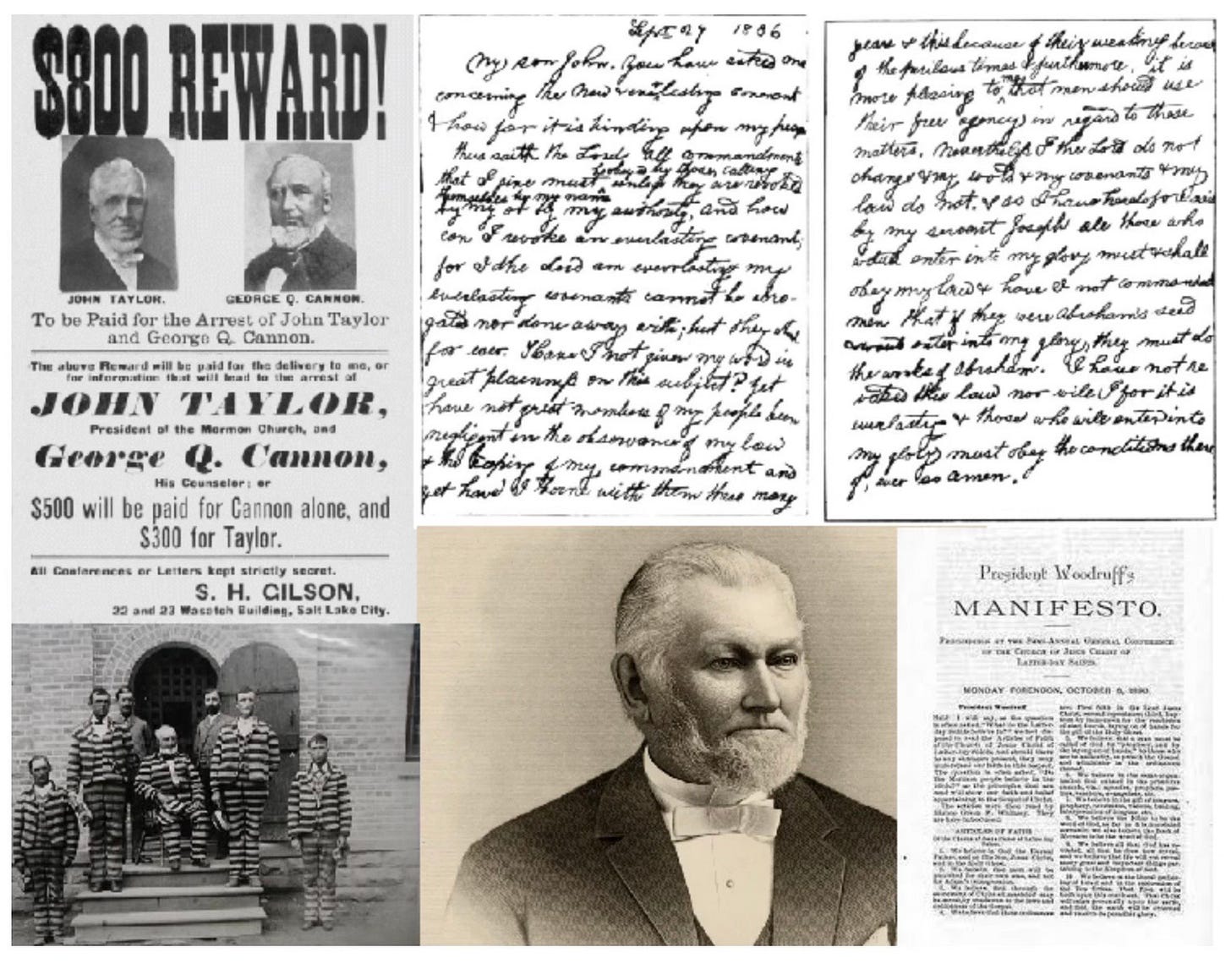
The previously shunned document didn’t just outline a practice of marriage, but a practice of polygamy, otherwise known as the new and everlasting covenant—the same language used in current-day Mormon scripture—Doctrine & Covenants section 132. When the Church publicly abandoned polygamy in 1890 under government pressure (see Manifesto above), this 1886 document became dangerous. It proved the Church’s surrender of the practice of polygamy was political, not theological.
For generations, they called the revelation a fraud, essentially distancing themselves from the theological foundation that legitimized the eternal practice of plural marriage. Even going so far as excommunicating believers who cited it (Quinn, 1994; Hale, 2015)1. They didn’t just deny the revelation—they used that denial to paint an entire sect as delusional, and the women Compton named—those sacrificed on polygamy’s altar—as hysterics rewriting a history the Church was busy erasing2.
Now—without fanfare—they’ve authenticated it through their quiet publication to the Church History catalogue. The scanned documents don’t lie—there’s J. Ruben Clark’s own initials approving the revelation’s authenticity—and a 1933 paper trail proving President Heber J. Grant and his inner circle knew it existed. The smoking gun wasn’t hidden. It was catalogued. Not a backroom forgery, but an institutional heirloom, preserved in First Presidency vaults while publicly denied for generations.
The Church provided no explanation for the century of lies. No reckoning with the lives destroyed by their denials. They just slipped it into the archives like it had always belonged.
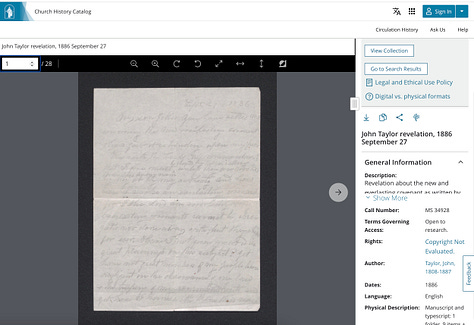
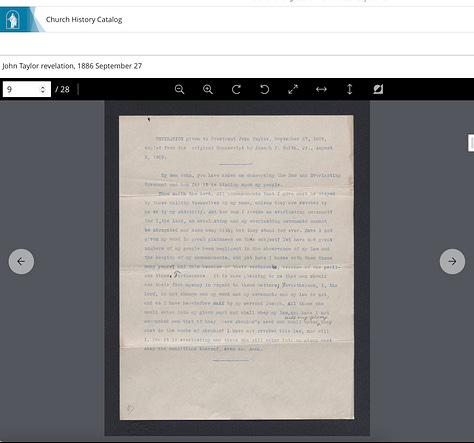
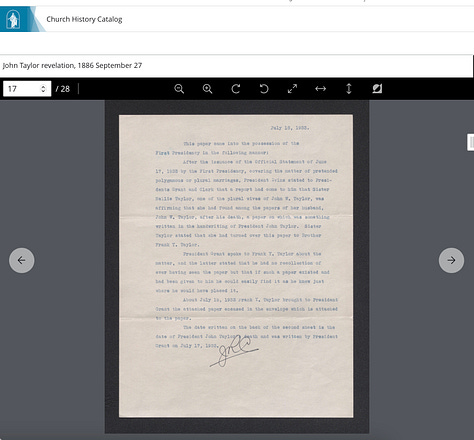
Here’s why that quiet admission matters more than they want you to think:
The 1890 Manifesto that “ended” the practice of polygamy was political theater—a surrender to U.S. law, not a doctrinal reversal. John Taylor’s 1886 revelation—now authenticated by the Church’s own archives—proves leaders continued teaching polygamy as an eternal principle long after the 1890 Manifesto, with apostles like John W. Taylor and Matthias F. Cowley performing secret plural marriages well into the 1920s3. As D. Michael Quinn proved, the Manifesto didn’t end polygamy, it just sent it underground.
The LDS Church wants you to believe polygamy was a historical blip, something practiced long ago, certainly not a modern practice. Which is true, to some extent. The practice is gone, but the doctrine remains. Their scriptures outlining its divinity, remain canon4. The Church refuses to disavow the practice of “eternal marriage” and temple sealing’s still bind women to men (never the other way around). In fact, men can still be sealed to multiple women leading to eternal polygamy, but the same cannot be said of women.
And we don’t even have to look very far for examples of this modern practice. Current President Russel M. Nelson, is married to two women. (One is dead, but the other knows full well that when she dies, she will be the second wife.) Do you think he’s going to give up one of his wives when he gets to heaven? F*ck no. Do you think the women will jockey for position, fighting it out in the Celestial realm? You bet ya.
However, let’s get down to brass tacks, this essay isn’t just about Church sanctioned archives, it’s about the system that made my suffering, and the suffering of girls like me, inevitable. The same theological framework that justified taking multiple wives—justified taking my voice, my child, my worth.
The Church didn’t just hide a document—they hid the blueprint.
The 1886 revelation wasn’t just about plural marriage. It was about control. It was an instruction manual for disappearance. Because the theology still exists that disappears a woman behind the legitimacy of eternal marriage.
The Revelation on the Eternity of the Marriage Covenant takes: Women’s bodies. Women’s voices. Women’s autonomy. Women’s very salvation.
The kind that could look a sixteen-year-old assault victim in the eye and say:
Your body is sin. (So we own it) Your baby is redemption. (So we can take it) Your silence is sacred. (So we demand it)
Here’s how the covenant played out on my teenaged body:
First, they turned assault into ‘sin,’ my womb into ‘repentance,’ and my child into a ‘blessing’ for someone else.
Then they fed my voice to the silence — the kind that smells like hospital antiseptic and tastes like the sacrament bread I couldn’t swallow the Sunday after my mother took my son. It tastes like standing in the funeral home, demanding my name— mother, mother, MOTHER—in his obituary. Thirty-five years later, the newspaper archives show no record of it ever running. No explanation. Just absence where my truth should have been.
The revelation wasn’t lost. I was.
For over a hundred years, they called the document a forgery. But no one questions the way bishops still moved through rooms like they held the deeds to our wombs, and owned our newborns’ first cries because bishops held the keys to our repentance and demanded our babies adoptions as payment. Then called it salvation and told us to be quiet about our pain.
The revelation wasn’t lost. It was working.
The Manifesto changed their public relations, their public image, possibly their tax exempt status, but not their doctrines. The 1886 handwritten document is proof. My life is proof. And the temple covenants that millions of Mormon women still make today?
That’s proof that the corpse still breathes, and it births new ghosts every time a woman kneels at the alter and mistakes surrender for salvation and calls it the new and everlasting covenant.5
Want to Help Expose the Lies?
Donate to fund records requests and legal filings
Share this essay like the statute of limitations depends on it
The LDS Church survives on silenced women. Let’s make that their fatal flaw.
Jennifer Crow is a writer, researcher, and former insider turned critic of the LDS Church. Her work exposes the hidden narratives of women silenced by religious systems—especially those coerced into silence through adoption, exile, and shame. She writes at the intersection of personal history, collective trauma, and sociological resistance. This essay is part of her ongoing investigation into how the Church’s policies were written in denial and paid for in women’s flesh.
D. Michael Quinn (Origins of Power, 1994) details how the Church excommunicated members in the early 20th century for defending post-Manifesto polygamy, including those who referenced the 1886 revelation. Quinn himself was later excommunicated from the LDS Church in 1993, as part of the "September Six," for his historical writings, including those on women and the priesthood and post-Manifesto polygamy.
Brian Hale (Joseph Smith’s Polygamy: History and Theology, Vol. 3, 2015) documents how LDS leaders consistently denied the revelation’s authenticity for decades and notes that fundamentalist groups (like the FLDS) were labeled “apostates” for teaching its legitimacy.
LDS Church Statements (Church News, 1940s-1980s) official denials of the revelation’s legitimacy. Some LDS Church leaders referred to the revelation as “concocted” and a “scheme” by “recalcitrant brethren.” The considered it a “false revelation” and pointed out that the revelation was not found within the LDS Church Archives (which is no longer true).
1921 Excommunication of Joseph W. Musser a prominent fundamentalist who cited the revelation. Musser believed that the LDS Church was wrong in abandoning plural marriage after the 1890 Manifesto, feeling they were giving in to the demands of the U.S. government instead of following God’s law.
Todd Compton (In Sacred Loneliness, 1997) discusses how the Church marginalized believers, especially women, in early polygamy revelations. Elucidates how the social realities of the practice led to hardship and the marginalization of women that are often left out of the official Church narrative.
D. Michael Quinn (The Mormon Hierarchy: Extensions of Power, 1997) the definitive exposé of LDS leadership’s secret post-Manifesto polygamy, financial schemes, and political machinations—meticulously sourced from Church archives they’d rather you ignore.
Doctrine and Covenants (Section 132) revelation given through Joseph Smith in 1843 relating to the “new and everlasting covenant,” the eternity of the marriage covenant and the principle of plural marriage.
Carol Lynn Pearson (The Ghost of Eternal Polygamy, 2016) highlights how the concept of eternal polygamy, where men can be sealed to multiple wives in heaven, continues to affect members of the Church of Jesus Christ of Latter-day Saints. Based on her own experiences and stories from thousands of others, the book examines the emotional and psychological harms that the concept of eternal polygamy takes on women of the church. Despite the official end of polygamy, Pearson argues that the idea continues to influence Mormon culture, causing pain, fear, and a sense of inequality for some members.






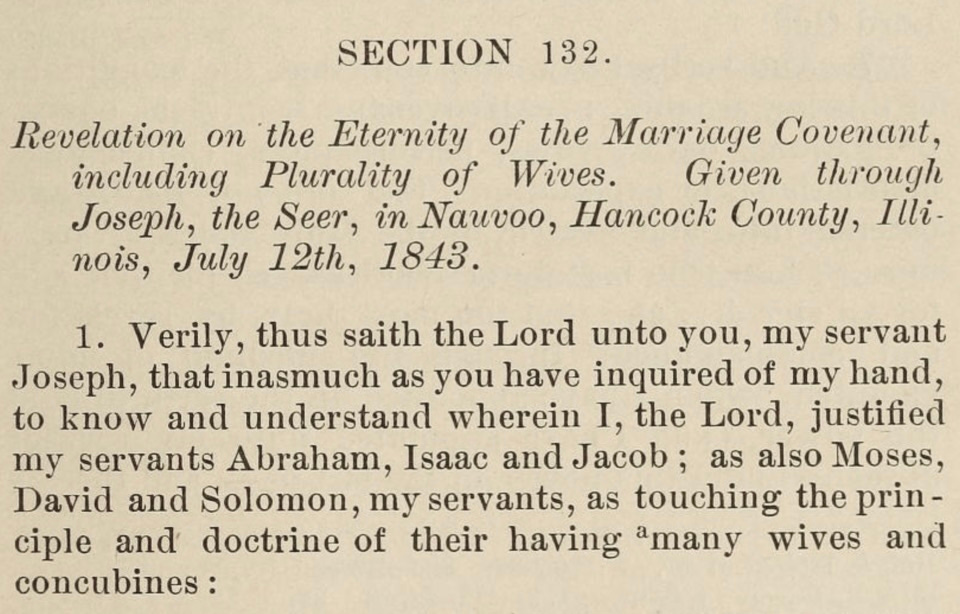

Jennifer, that is a huge load of loss to carry. I’m so very sorry to learn about the abuse you suffered. ❤️🩹🕊️